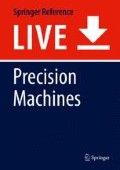Abstract
Mechanical polishing with abrasive slurry is a kind of finishing process that can reduce the surface roughness and improve the form accuracy effectively. In this chapter, the development of a serial-parallel machine for precision polishing of freefrom surface is presented. The topological structure of the machine is a six degrees-of-freedom (DOF) hybrid serial-parallel mechanism, including a three-DOF parallel mechanism, a two-DOF serial mechanism, and a functional extension limb providing a redundant DOF. The main features of the polishing machine are reflected in two aspects including the following: (1) the machine inherits the advantages of both serial mechanism and parallel mechanism, and (2) the rotation and translation motions between the polishing tool and the workpiece are decoupled. In this chapter, a systematic kinematics and stiffness analysis of the hybrid serial-parallel mechanism are performed. Afterward, the development of the polishing machine is explained. Finally, some preliminary experiments have been conducted on a saddle surface which aim to evaluate the performance and demonstrate the capability of the machine.
References
Allen LN (1995) Progress in ion figuring large optics. Proc SPIE – Int Soc Opt Eng 2428:237–247
Bonev IA, Ryu J (2001) A new approach to orientation workspace analysis of 6-DOF parallel manipulators. Mech Mach Theory 36:15–28
Brecher C, Lange S, Merz M, Niehaus F, Wenzel C, Winterschladen M (2006) NURBS based ultra-precision free-form machining. CIRP Ann-Manuf Techn 55:547–550
Chablat D, Wenger P, Majou F, Merlet JP (2004) An interval analysis based study for the design and the comparison of three-degrees-of-freedom parallel kinematic machines. Int J Robot Res 23:615–624
Chen C, Angeles J (2007) Generalized transmission index and transmission quality for spatial linkages. Mech Mach Theory 42:1225–1237
Clavel R (1990) Device for the movement and positioning of an element in space. US Patent
Fan C, Zhao GL, Zhao J, Zhang L, Sun LN (2015) Calibration of a parallel mechanism in a serial-parallel polishing machine tool based on genetic algorithm. Int J Adv Manuf Tech 81:27–37
Gosselin C, Angeles J (1989) The optimum kinematic design of a spherical 3-degree-of-freedom parallel manipulator. J Mech Transm-T Asme 111:202–207
Gosselin C, Angeles J (1991) A global performance index for the kinematic optimization of robotic anipulators. J Mech Design 113:220–226
Innocenti C, Parenticastelli V (1990) Direct position analysis of the Stewart platform. Mech Mach Theory 25:611–621
Kakinuma Y, Igarashi K, Katsura S, Aoyama T (2013) Development of 5-axis polishing machine capable of simultaneous trajectory, posture, and force control. CIRP Ann-Manuf Techn 62:379–382
Kordonski WI, Golini D (1999) Fundamentals of magnetorheological fluid utilization in high precision finishing. J Intel Mat Syst Str 10:683–689
Liao L, Xi FF, Liu KF (2008) Modeling and control of automated polishing/deburring process using a dual-purpose compliant toolhead. Int J Mach Tool Manu 48:1454–1463
Lin WY, Li B, Yang XJ, Zhang D (2013) Modelling and control of inverse dynamics for a 5-DOF parallel kinematic polishing machine. Int J Adv Robot Syst 10:1–21
Lin W, Xu P, Li B, Yang X (2014) Path planning of mechanical polishing process for freeform surface with a small polishing tool. Robot Biomim 1:1–15
Liu X-J (2005) Optimal kinematic design of a three translational DoFs parallel manipulator. Robotica 24:239
Liu XJ, Wang JS, Oh KK, Kim J (2004) A new approach to the design of a DELTA robot with a desired workspace. J Intell Robot Syst 39:209–225
Martin HM, Anderson DS, Angel JRP, Nagel RH, West SC, Young RS (1990) Progress in the stressed-lap polishing of a 1.8-M F/1 mirror. Proc SPIE – Int Soc Opt Eng 1236:682–690
Merlet JP (1994) Parallel manipulators – state-of-the-art and perspectives. Adv Robotics 8:589–596
Sidpara A, Jain VK (2013) Analysis of forces on the freeform surface in magnetorheological fluid based finishing process. Int J Mach Tool Manu 69:1–10
Tsai LW, Joshi S (2000) Kinematics and optimization of a spatial 3-UPU parallel manipulator. J Mech Design 122:439–446
Tsai MJ, Lee HW (1994) Generalized evaluation for the transmission performance of mechanisms. Mech Mach Theory 29:607–618
Walker DD, Brooks D, King A, Freeman R, Morton R, McCavana G, Kim SW (2003) The ‘Precessions’ tooling for polishing and figuring flat, spherical and aspheric surfaces. Opt Express 11:958–964
Walker DD, Freeman R, Morton R, McCavana G, Beaucamp A (2006) Use of the ‘Precessions’(TM) process for prepolishing and correcting 2D & 2 1/2 D form. Opt Express 14:11787–11795
Wampler CW, Morgan AP, Sommese AJ (1990) Numerical continuation methods for solving polynomial systems arising in kinematics. J Mech Design 112:59–68
West SC et al (1994) Practical design and performance of the stressed-lap polishing tool. Appl Opt 33:8094–8100
Xu P, Cheung CF, Li B, Ho LT, Zhang JF (2017) Kinematics analysis of a hybrid manipulator for computer controlled ultra-precision freeform polishing. Robot Com-Int Manuf 44:44–56
Yoshikawa T (1985) Manipulability of robotic mechanisms. Int J Robot Res 4:3–9
Yu JJ, Dai JS, Zhao TS, Bi SS, Zong GH (2009) Mobility analysis of complex joints by means of screw theory. Robotica 27:915–927
Acknowledgments
The authors would like to express their sincere thanks to the Innovation and Technology Commission (ITC) of the Government of the Hong Kong Special Administrative Region (HKSAR) for the financial support of the research work under the project No. GHP/031/13SZ. The work was also supported a PhD studentship (project account code: RU98) from the Hong Kong Polytechnic University.
Author information
Authors and Affiliations
Corresponding author
Editor information
Editors and Affiliations
Rights and permissions
Copyright information
© 2020 Springer Nature Singapore Pte Ltd.
About this entry
Cite this entry
Xu, P., Cheung, C.F., Li, B., Wang, C., Ho, L.T. (2020). Design, Development, and Analysis of a Hybrid Serial-Parallel Machine for Precision Polishing. In: Yang, S., Jiang, Z. (eds) Precision Machines. Precision Manufacturing. Springer, Singapore. https://doi.org/10.1007/978-981-10-5192-0_20-1
Download citation
DOI: https://doi.org/10.1007/978-981-10-5192-0_20-1
Received:
Accepted:
Published:
Publisher Name: Springer, Singapore
Print ISBN: 978-981-10-5192-0
Online ISBN: 978-981-10-5192-0
eBook Packages: Springer Reference EngineeringReference Module Computer Science and Engineering

